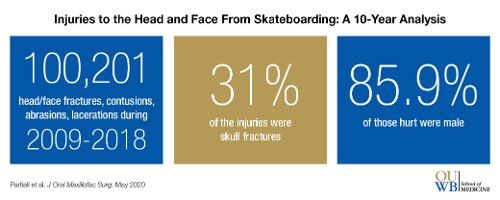
More injury prevention programs and increased helmet use is needed to prevent serious injury from skateboarding, says a recently published, first-of-its-kind study from a team of medical students at Oakland University William Beaumont School of Medicine.
“Injuries to the Head and Face From Skateboarding: A 10-Year Analysis From National Electronic Injury Surveillance System Hospitals” was published in May in the Journal of Oral and Maxillofacial Surgery. The study also was presented at the Oakland University Graduate Student Research Conference earlier this year (prior to COVID-19).
Among other things, the study finds those most prone to head and face injuries incurred while skateboarding are male teens.
Lead author was Benjamin Partiali, a rising fourth-year medical student at OUWB who said his interest in skateboard-related injuries stems from his experience as a youngster in California.
“I’m from Santa Monica, which is a big surfer and skater area,” he said. “Me and my friends were always skating and getting banged up so that’s where my original idea came from — how often are people getting head and face fractures specifically from skateboarding?”
“This is the first study to characterize skateboard-related fractures of the head and face,” the paper states.
“With the addition of skateboarding to the 2021 Olympics, the exposure to and popularity of the sport may increase. With limited adherence to helmet use and substantial adolescent participation, the risk of head and facial trauma may likely increase, especially in novice skateboarders.”
The number of people skateboarding in the U.S. has remained relatively consistent during the last decade with about 6 million stepping on a board annually, according to Statista.
However, Partiali said he couldn’t find details specific to head injuries sustained as a direct result of skateboarding accidents.
 Knowing those numbers is important, he said, because “A lot of TBIs (traumatic brain injuries), really bad concussions, and head injuries really have negative effects on development.”
Knowing those numbers is important, he said, because “A lot of TBIs (traumatic brain injuries), really bad concussions, and head injuries really have negative effects on development.”
Partiali (shown in picture) led a small team that combed through the National Electronic Injury Surveillance System (NEISS) database to produce a report specific to skateboard-related head and face fractures, contusions, abrasions, and lacerations from 2009 through 2018. (The research team also included OUWB third-year medical students (M3s) Sandra Oska and Antonio Barbat.)
The team found 2,519 reported injuries, extrapolating to a national incidence of 100,201 injuries (based on the NEISS weighting algorithm).
Fractures accounted for 14.1 percent of the visits.
The team drilled down further to look at demographics, fracture type, mechanism of injury, and disposition.
Per the report, patients sustaining injury to the head and face were 16 years old, on average, and predominantly male (86 percent). The most common fracture types were unspecified skull fractures (31 percent), nasal fractures (29 percent), and mandibular fractures (18 percent).
Of those injured, 77 percent were hurt while riding. The report also found that about 7 percent of injuries occurred as the result of an accident with a motor vehicle.
“Given the neurologic outcomes of head trauma and functional consequences of facial fractures, especially among adolescents, our findings suggest that injury prevention programs and more aggressive helmet use may be necessary to reduce morbidity and hospitalization,” the paper states.
Partiali said it’s important to note that the study isn’t anti-skateboarding.
“We want people to enjoy the sport and think it’s great that it’s being recognized and now in the Olympics, which I’m sure will increase its exposure,” he said. “But having safety measures and talking about wearing helmets and protective gear to prevent these bad outcomes and consequences is really important, especially for the young population that tends to ride skateboards.”
For more information, contact Andrew Dietderich, marketing writer, OUWB, at [email protected].
Follow OUWB on Facebook, Twitter, and Instagram.
NOTICE: Except where otherwise noted, all articles are published under a Creative Commons Attribution 3.0 license. You are free to copy, distribute, adapt, transmit, or make commercial use of this work as long as you attribute Oakland University William Beaumont School of Medicine as the original creator and include a link to this article.

